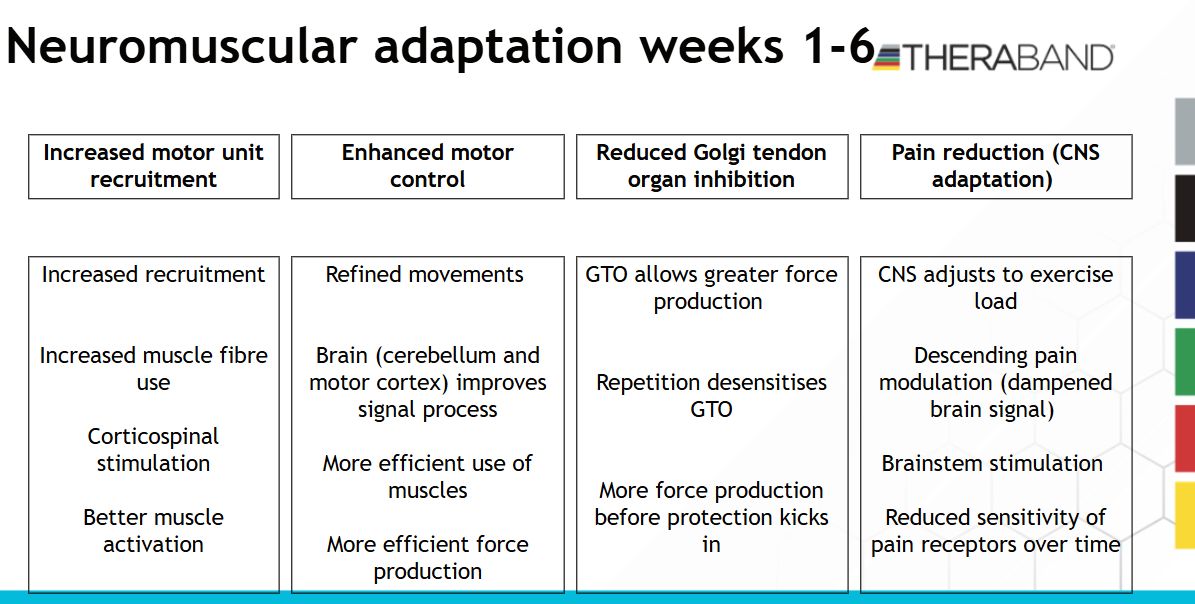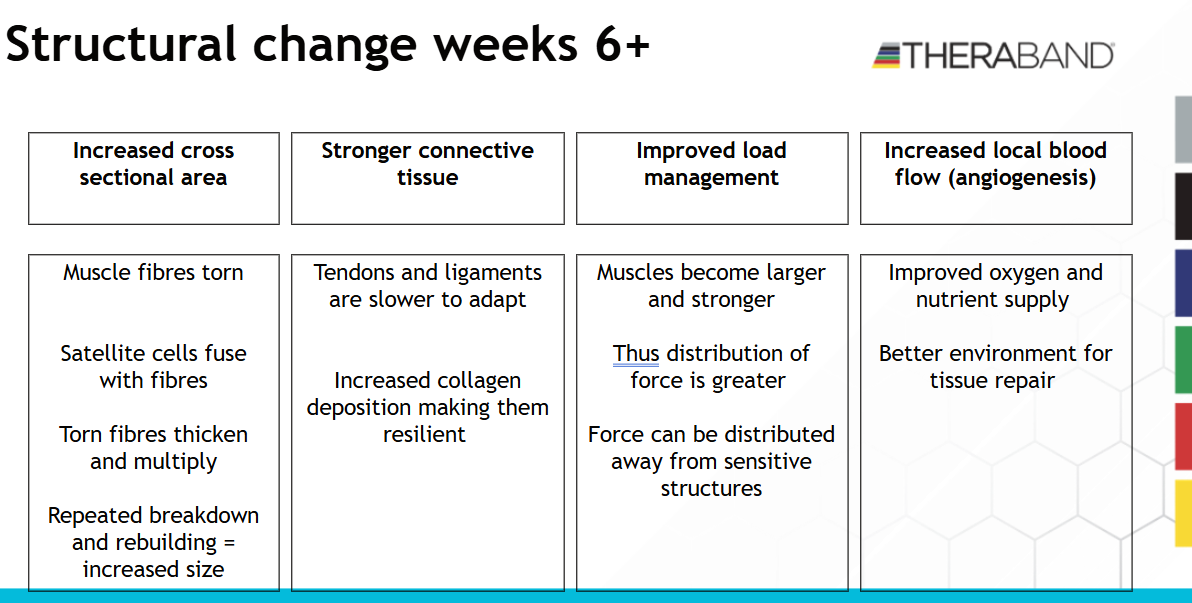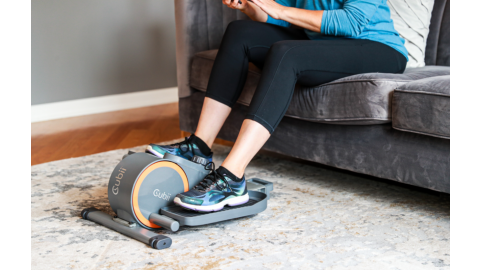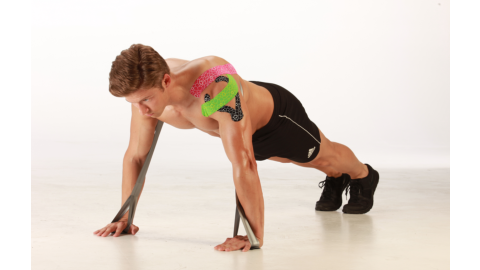This webinar is presented by Tom Stanley, a physiotherapist and a business development manager at Performance Health. He’s worked in rehab and strength and conditioning physiotherapy for the last 10 years.
With this webinar, Tom’s goal is to show how strength and conditioning concepts directly enhance patient outcomes. And with unique features such as quality control, color-coded progression and evidence-based success, THERABAND products make it especially effective.
The objective of this webinar is to demonstrate how to maximize the amazing research and technology behind THERABAND and apply them in a healthcare setting working with those in need of rehabilitation and pain support.
The following is an outline from which Tom worked off to present the webinar, supplemented periodically with what he talked about during his presentation. View the full webinar here.
Advanced Strength & Conditioning Concepts for Rehabilitation


Prescribing exercise is valuable for two reasons:
1. Neuromuscular Adaptation
Within the first 6 weeks of the prescribed exercise regime, patients can expect to see increased motor unit recruitment, enhanced motor control, reduced golgi tendon organ inhibition, and pain reduction.
2. Structural Change
After 6 weeks of the prescribed regimen patients often experience increased cross-sectional area, stronger connective tissue, improved load management, and increased local blood flow.




There are five key strength and conditioning concepts:
1. SAID Principle (Specific Adaptation to Imposed Demands)
Exercises must match the functional demands placed on tissues to achieve optimal adaptation.
- How THERABAND Helps
- Directional Versatility: THERABAND can be anchored at various angles, allowing you to replicate real-life movement patterns (e.g., sport or daily activity motions).
- Customisable Resistance: Adjust tension easily (by stepping closer/farther from the anchor) to ensure the exercises closely mimic the forces encountered in everyday activities.
- Why THERABAND Is Unique
- Consistent Resistance Profile: THERABAND’s materials are designed for uniform elasticity, reducing ‘snap’ or uneven tension.
- Extensive Clinical Validation: Research and clinical protocols frequently cite THERABAND by name, so you can integrate SAID-based exercises with confidence in the product’s reliability.
2. Tissue Capacity & Load Management
Balancing mechanical stress (load) and recovery to safely increase tissue tolerance.
- How THERABAND Helps
- Incremental Load Adjustments: Colour-coded bands allow fine-tuned progression, preventing sudden spikes in load that risk re-injury.
- Real-Time Feedback: Patients or therapists can instantly reduce or increase tension based on patient comfort or objective markers (e.g., VAS pain rating).
- Why THERABAND Is Unique
- Published Tension Values: Each colour’s resistance has been extensively documented, enabling precise load prescription rather than guesswork.
- Durable Construction: Inferior or cheaply made bands can degrade quickly and alter tension unpredictably; THERABAND’s quality means stable, repeatable loads over time.
3. Eccentric, Concentric & Isometric Training
Different contraction types target varied adaptations - eccentric for tendon remodeling, concentric for hypertrophy and isometric for stabilization/pain control.
- How THERABAND Helps
- Smooth Transition: The elasticity of THERABAND makes switching between these contraction types seamless (e.g., from concentric to eccentric phases).
- Isometric Holds: Holding tension against the band is an easy way to isolate specific muscle groups at a targeted joint angle.
- Why THERABAND Is Unique
- Known Elastic Integrity: THERABAND’s consistent elasticity ensures predictable tension, especially in the eccentric phase where abrupt changes can hinder progress.
- Latex & Latex-Free Options: Provide safe usage for all patient populations without sacrificing uniform resistance.
4. Periodisation & Micro-Progressions in Rehab
Structuring rehab in phases (linear, undulating, etc.) with systematic, smaller increases in load or volume.
- How THERABAND Helps
- Colour-Coded Progression: Bands move from lower to higher resistance (yellow, red, green, blue, black, etc.) in a well-documented progression system.
- Simple to Scale: You can increase reps/sets or switch to a higher-resistance band, mirroring periodization principles without complex equipment.
- Why THERABAND Is Unique
- Trusted Progression™ System: THERABAND pioneered colour-coded progression, offering clinicians a straightforward roadmap for rehab phasing.
- Evidence-Based: Peer-reviewed studies often specify THERABAND’s exact color jumps, enhancing research-backed periodization in clinics.
5. Velocity-Based Training & Power Development
Integrating speed or explosive movements into rehab to prepare for return-to-sport or high-demand ADLs.
- How THERABAND Helps
- Gradual Resistance Increase: Tension increases with elongation, which is safer for introducing explosive or rapid movements.
- Variable Movement Speeds: Patients can practice slow, controlled lifts before progressing to faster, more dynamic drills using the same piece of equipment.
- Why THERABAND Is Unique
- Consistent Elastic Properties: Ensures a smoother buildup of force, reducing joint stress compared to free weights or cheaper elastic alternatives.
- Extensive Resource Library: THERABAND frequently provides guides on advanced training variables, including safe methods to incorporate power.
Integrating THERABAND into Advanced S&C for Rehab
- Versatility & Accessibility:
- How THERABAND Helps: Light, portable, easy to anchor - ideal for home programs or clinic use.
- Why THERABAND Is Unique: Recognized brand with widely available product lines, ensuring you and your patients have consistent access to the same quality bands.
- Objective Progression with Colour-Coded Bands
- How THERABAND Helps: Clinicians can monitor and log each color jump to match or surpass specific strength targets.
- Why THERABAND Is Unique: The brand’s well-researched tension data ensures each color step is a validated increase, making micro-progression more accurate.
Practical Applications: Case Studies & Exercise Examples
Applying these exercises with tempo is a fantastic way to help your patient build strength and to track progress. Incorporating tempo in a described sequence of 4 numbers (e.g. 3-1-3-1) can introduce a powerful stimulus change, encourage neuromuscular plasticity and impact load. This can all be as important as your band selection when prescribing the exercise. Consider the following questions when applying tempo:
- Do you need to target a specific range of motion? (3-3-1-1 for squat)
- Do you need eccentric emphasis? (5-1-1-1)
- Do you need speed? (3-1-1-1) (1-1-1-1)
- Are you seeking to prevent re-injury?
- Injury location?
- Phase of rehab?
Case Study 1: Rotator Cuff Rehab (SAID & Eccentric Loading)
- How THERABAND Helps
- Anchor bands overhead or at varying angles for replicating real-life shoulder movements.
- Focused eccentric phases for tendon remodeling with safe, incremental tension changes.
- Why THERABAND Is Unique
- Quality ensures consistent tension session to session, essential for shoulder rehab where sudden snapping or uneven tension can set progress back.
Case Study 2: Medial Epicondylitis (Periodized Approach)
- How THERABAND Helps
- Start with isometric holds for pain control, move to eccentric and/orconcentric loading, and finally moderate-velocity band work.
- Why THERABAND Is Unique
- Published clinical protocols often detail band color transitions for elbow rehab, simplifying evidence-based practice for clinicians.
It’s important to note the difference between regular THERABAND resistance bands and CLX bands with loops. When the loops are added in, the load of the band doubles. So, when prescribing exercises with resistance bands, be sure to make your patients aware of the differences between these two types of THERABAND resistance bands.
Case Study 3: Lower Limb Strength & Power Restoration
- How THERABAND Helps
- Allows “mini-plyos” and explosive movements in a safer environment (resistance is lower at the beginning of the range).
- Why THERABAND Is Unique
- Extensive product testing and consistent force curves support advanced rehab methods without unexpected overload.
Implementation Strategies in Clinical Practice
- Data-Driven Progressions
- How THERABAND Helps: Measurable tension ranges let you align band selection with objective strength or function tests.
- Why THERABAND Is Unique: Widely published tension values for each color give a precise starting point and trackable increments.
- Phase-Based Approach
- How THERABAND Helps: Same brand from acute (light tension) to performance-based phases (higher tension).
- Why THERABAND Is Unique: No need to juggle multiple brands with inconsistent tension—THERABAND supports an entire rehab journey.
Deloading can be an incredibly valuable process to put your patient through to see the results you’re looking for.
- Common Pitfalls & Troubleshooting
- How THERABAND Helps: Its uniform stretch reduces the chance of error or improper progression.
- Why THERABAND Is Unique: Superior durability means fewer unexpected snaps or tension variability that can risk injury or regress patient progress.


Recap:
- Each advanced S&C concept seamlessly aligns with THERABAND’s specific design features.
- The proven reliability, consistent elasticity, and validated progression data set THERABAND apart from generic brands.Shape
Overall Emphasis
THERABAND isn’t just another resistance band:
- It’s backed by research and trusted across healthcare settings.
- It delivers predictable, consistent tension that aligns perfectly with advanced S&C principles.
- Its color-coded system facilitates micro-progression, periodization, and velocity-based training without the guesswork.
View the full webinar:
Article primarily written by Tom Stanley with supplemental additions made by Michelle Kok.
References
- Muscle Adaptations (Hostler et al., 2001): Demonstrates that both young men and women experience significant skeletal muscle adaptations through elastic resistance training.
- Elastic Band Mechanics (Santos et al., 2009): Explores the mechanical properties and resistance variability of elastic bands, underscoring their reliability for consistent resistance training.
- Knee Osteoarthritis and Elastic Bands (Chang et al., 2012): Shows improvement in lower extremity function among women with knee osteoarthritis using elastic band exercises, highlighting their therapeutic value.
- Closed vs. Open Kinetic Chain Exercises (Cho et al., 2014): Investigates the effects of elastic band exercises in closed and open kinetic chain movements, finding benefits in managing degenerative joint conditions.
- Home-Based Training for Older Adults (Mikesky et al., 1994): Validates the effectiveness of elastic tubing in improving muscular strength and function among older adults in a home-based program.
- Theraband Tubing Properties (Patterson et al., 2001): Details the material properties of Theraband tubing, establishing their durability and uniform resistance.
- Elastic Resistance vs. Conventional Training (Lopes et al., 2019): A systematic review and meta-analysis comparing elastic resistance to traditional methods, showing comparable improvements in strength.
- Variable Resistance Training (Bahram et al., 2020): Examines the effects of combining elastic bands with traditional weights, finding enhancements in muscular strength and endurance among untrained individuals.
- Elastic Resistance vs. Conventional Resistance Training: A 2019 systematic review and meta-analysis by Lopes et al. compared elastic resistance training to traditional resistance methods. The findings indicated that elastic resistance is as effective as conventional resistance training in improving muscle strength, offering a practical and cost-effective alternative.
- SAGE Journals: Elastic Resistance Training in Older Adults: A 2013 meta-analysis by Martins et al. focused on older adults and found that elastic resistance training significantly enhances muscle strength in this demographic. The study highlighted the benefits of elastic resistance exercises in improving physical function and reducing the risk of falls among the elderly.
- Europe PMC: Elastic Resistance Training in Healthy Adults: A 2017 systematic review and meta-analysis by de Oliveira et al. examined the effects of elastic resistance training on muscle strength and functional performance in healthy adults. The results demonstrated that elastic resistance exercises effectively improve muscle strength and functional performance, making them a viable option for strength training in healthy individuals.
Medical Disclaimer: The information provided on this site, including text, graphics, images, and other material are for informational purposes only and are not intended to substitute for professional medical advice, diagnosis, or treatment. Always seek the advice of your physician or other healthcare professional with any questions or concerns you may have regarding your condition.






 US
US France
France Australia
Australia





